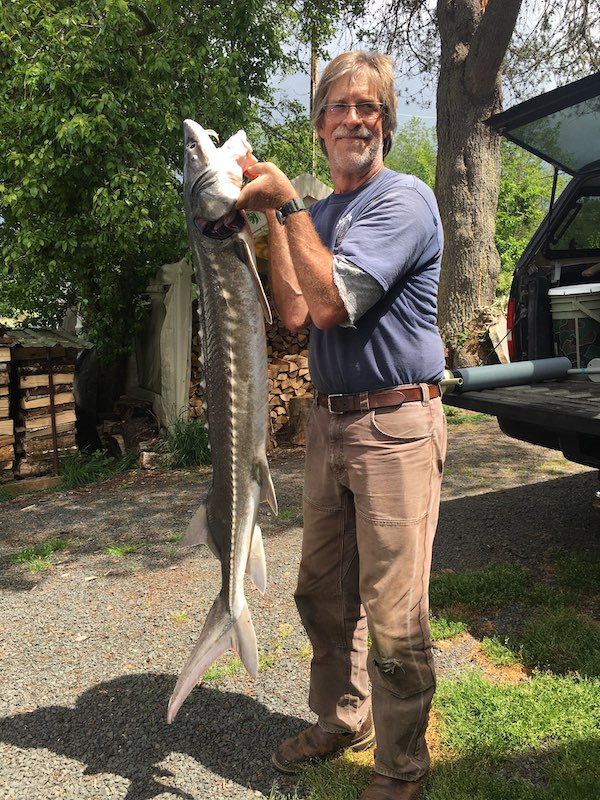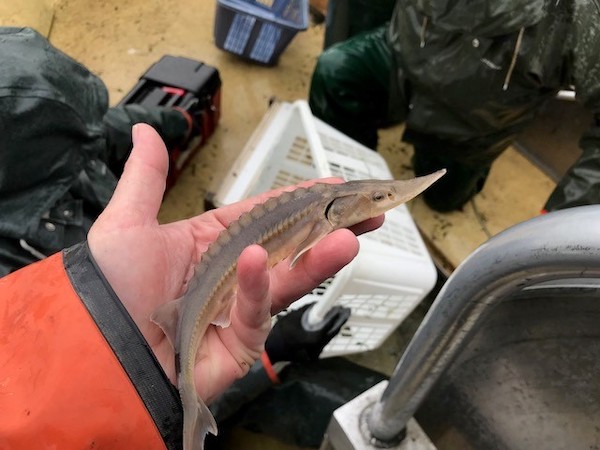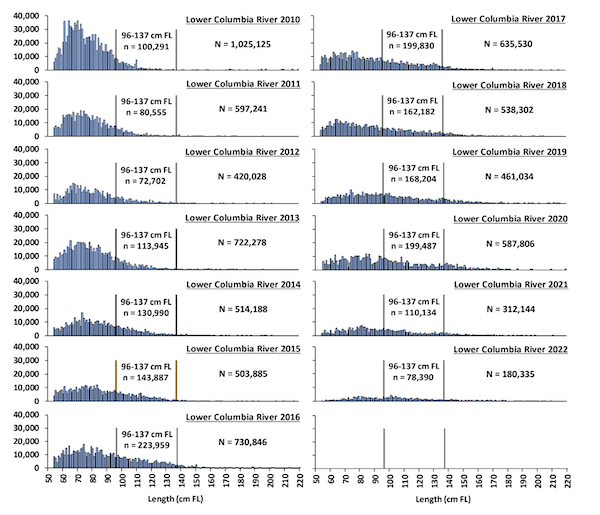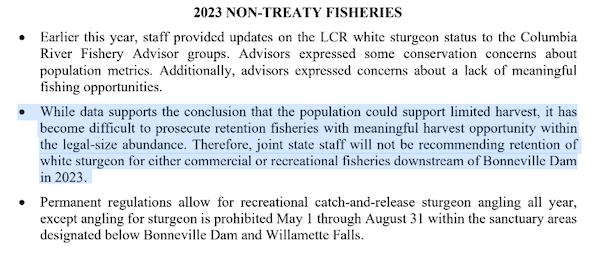
No Keeper Sturgeon Fishery On Columbia Below Bonneville In 2023
Catch and release fishing will continue as usual, of course, but don’t expect any sturgeon retention opportunities on the Lower Columbia this year.

Staffers from ODFW and WDFW made that recommendation today for the waters from Buoy 10 upstream to Bonneville as the overall sturgeon population continues to decline, driven by poor recruitment of juveniles. No commercial season will be recommended either.
“We have met our goals for growing more spawning-size adults into the population and we see some Age-0 fish every year that we look, but we aren’t seeing enough of these little fish to maintain that productive fishery,” said WDFW sturgeon lead Laura Heironimus this afternoon.
Those little fish, of course, become the slot-limit fish that power keeper fisheries on the estuary in the spring and above the Wauna powerlines and in the Cowlitz in early fall.
But according to today’s update from state managers, there were only an estimated 78,400 retainable sturgeon (those with a nose to tail fork length of 38 to 54 inches) last year, the second fewest since 2010, and just a third of the recent high, 2016’s 224,000.
“Fewer fish in the legal-size slot means fewer fish available for harvest,” Heironimus says. “In the past few years we’ve been shrinking that harvestable guideline along with the shrinking legal-size abundance, and now we are at a point where that harvestable guideline is too small to set meaningful fisheries. By meaningful fisheries, we mean it’s becoming increasingly difficult to open a day of fishing on a day where people are able to participate and actually catch a fish.”
Last year, 3,200 fish were available below Bonneville and anglers kept 2,183 during the select days in spring and fall the waters were open for harvest.

Heironimus says that with a smaller harvest guideline and how many people participate in the fishery, the model that managers use “just isn’t working anymore.”
Oregon’s and Washington’s Fish and Wildlife Commissions allocate 80 percent of the harvestable surplus to recreational fisheries, 20 percent to the commercials. In response to declining stocks, ODFW’s commission uses a 10 percent conservation buffer, while WDFW’s “requires the fishery be managed with a precautionary approach due to uncertainties in population parameters.”
According to the fishery update, recreational fishing advisors briefed on the matter “expressed some conservation concerns about population metrics. Additionally, advisors expressed concerns about a lack of meaningful fishing opportunities.”
If there’s good news, it’s that the number of oversize fish – those that are longer than keeper size – has been above the desired threshold of 9,250 each of the last four years.
But why they aren’t producing more young is the “million-dollar question,” says Heironimus.

“I think that pinnipeds are one major concern, directly through predation on sturgeon and indirectly by changing spawning sturgeon behaviors to avoid predation and either not spawn or spawn somewhere less suitable for eggs/larvae to survive,” she says.
Pinnipeds translates to sea lions, and in the case of sturgeon, Stellers are the primary predator. A management report out earlier this year notes that while consumption at Bonneville has waned since the early 2000s, that’s “likely the result of white sturgeon avoiding this area in the spring and instead seeking out other areas of the Columbia River and tributaries.”
Meanwhile, sturgeon predation at the dam has been increasing during the fall months, and of course it occurs throughout the lower river, one reason anglers should use an online tool to report their seal lion and harbor seal sightings. Data from it is expected to be used to “investigate potential pinniped ‘hot spots’ for future research or management activities.” After Congress tweaked the Marine Mammal Protection Act, state and tribal managers received a federal permit for expanded removals of sea lions in the Lower Columbia and its salmon-bearing tribs, but they need documentation.

“But there are a lot of other constraints in the ecosystem that are affecting all of the fish, and it’s not just limited to the Lower Columbia,” Heironimus notes.
Sturgeon numbers in big river below the dam declined from an estimated 1.025 million in 2010 to 180,335 in 2022.
“Some of the other constraints affecting sturgeon reproduction and recruitment include things such as climate change and hydrosystem operations affecting the timing and magnitude of temperature and flow in the spawning grounds, changes in the availability of sturgeon prey (i.e., other fish and shellfish), a lagging effect from previous decades of harvest, contaminants affecting reproductive potential in spawning adults, etc.,” Heironimus says.
As late as the late 1990s, anglers harvested over 50,000 sturgeon annually in the Lower Columbia, but that began to wane through the 2000s and had dropped sharply to 18,500 by 2010. As concerns grew, there were three back-to-back-to-back years – 2014-16 – that no sturgeon were allowed to be harvested in the river below Bonneville. Limited seasons were reinstated in 2017 with a guideline of 6,235. Despite available fish, ODFW has declined to open keeper fisheries in the Willamette below the falls.
